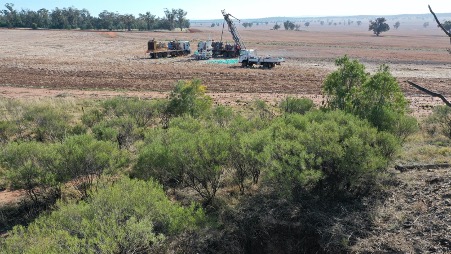Thomson Resources (ASX: TMZ) has obtained “outstanding” tin mineralization in additional diamond drilling assay results from the wholly-owned Bygoo Tin Project, located in the Lachlan Fold Belt in New South Wales, Australia.
The company completed two diamond holes at Bygoo North, which returned solid rock core samples in 2022 and have been the subject of interpretation and analysis.
Executive Chairman David Williams said these new high-grade tin results exceed expectations that originally occurred from preliminary analysis through core logging and testing with a portable XRF analyser. As a result, additional core samples were selected from these holes and two older diamond core holes drilled in previous years.
“The Bygoo Tin Project continues to deliver outstanding tin results reinforcing the potential of the project and the Lachlan Fold Belt,” Mr Williams said.
“The constant review by the team continues to reap rewards and provides a greater understanding of the mineralization at the Bygoo Project.
“The continuing presence of high-grade tin mineralization demonstrates the importance of this project.”
BNRC016D was drilled from north to south, following up a major intersection in BNRC013.2 At the time the division of this intercept into three named separate zones (Upper, Main and Link) had not been developed. The cassiterite mineralization at 82m depth was noted but was considered an outlier as it was much too shallow to be associated with that found in BNRC013. The discovery of the P380 Zone with BNRC073 (23m at 1.4% Sn) occurred much later and it is only now that this intercept of 2.2m at 4.0% Sn in BNRC016D can be shown to fit into that modelled zone.
Further down BNRC016D there are several more significant intercepts. When combined they aggregate to 36.7m at 0.4% Sn from 92.4m, which includes some higher-grade hits – 1.2m at 2.3% Sn from 125.3m and 1.4m at 2.2% Sn from 127.7m. The higher grade is close to an intersection from BNRC013 – 23m at 1.0% Sn: that intersection also did not fit with the Main Zone model at the time and is now interpreted to be from a “Link” zone between the Main and P380 zones.
Mr Williams said it is clear from the current interpretation that BNRC016D did not reach the Main Zone target.
Diamond core hole BNRC065D was another attempt to drill the Main Zone from the north and this was situated 20m to the west of BNRC016D. Logging of core noted several small indications of cassiterite but low results from the XRF analyser meant that, like BNRC016D, the core was not cut for assay at that time.
Again, like BNRC016D, the hole failed to reach the targeted Main Zone. With the new core assay results from later diamond drilling, the hole was reevaluated, and several sections were cut and assayed with good results – in particular 13.6m at 0.6% Sn from 103.42m depth which included a higher-grade portion of 3.0m at 2.3% Sn from 113.4m.
This intercept now makes sense because it aligns exactly with the interpreted position of the P380 tin greisen, discovered a few weeks later with BNRC073 – (23m at 1.4% Sn).
BNRC080D and BNRC084D had some small extra intervals assayed which resulted in small additions to the intercept widths
For further information please visit: https://www.thomsonresources.com.au/












